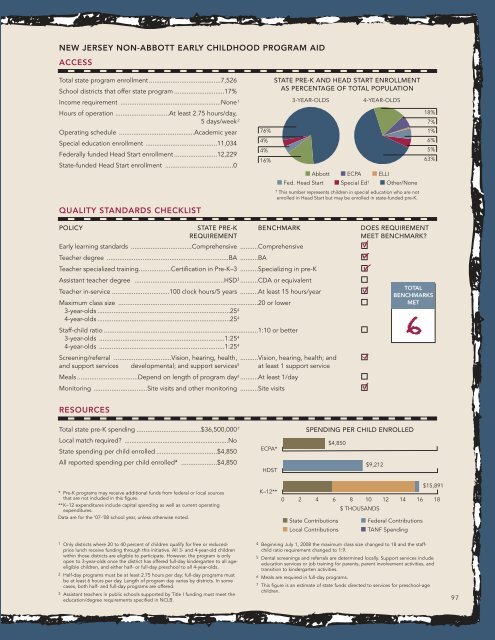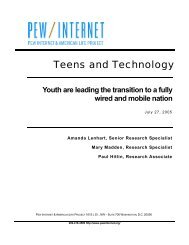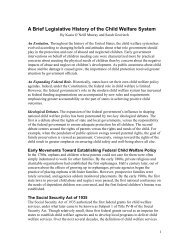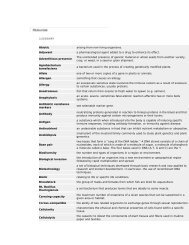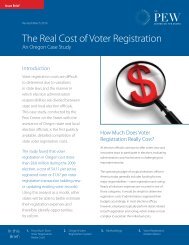Report: The State of Preschool 2008: State Preschool Yearbook
Report: The State of Preschool 2008: State Preschool Yearbook
Report: The State of Preschool 2008: State Preschool Yearbook
Create successful ePaper yourself
Turn your PDF publications into a flip-book with our unique Google optimized e-Paper software.
NEW JERSEY NON-ABBOTT EARLY CHILDHOOD PROGRAM AID<br />
ACCESS<br />
Total state program enrollment ........................................7,526<br />
School districts that <strong>of</strong>fer state program ............................17%<br />
Income requirement ........................................................None 1<br />
Hours <strong>of</strong> operation ..............................At least 2.75 hours/day,<br />
5 days/week 2<br />
Operating schedule ..........................................Academic year<br />
Special education enrollment ........................................11,034<br />
Federally funded Head Start enrollment ........................12,229<br />
<strong>State</strong>-funded Head Start enrollment ......................................0<br />
QUALITY STANDARDS CHECKLIST<br />
76%<br />
4%<br />
4%<br />
16%<br />
STATE PRE-K AND HEAD START ENROLLMENT<br />
AS PERCENTAGE OF TOTAL POPULATION<br />
3-YEAR-OLDS<br />
4-YEAR-OLDS<br />
■ Abbott ■ ECPA ■ ELLI<br />
■ Fed. Head Start ■ Special Ed † ■ Other/None<br />
† This number represents children in special education who are not<br />
enrolled in Head Start but may be enrolled in state-funded pre-K.<br />
18%<br />
7%<br />
1%<br />
6%<br />
5%<br />
63%<br />
POLICY STATE PRE-K BENCHMARK DOES REQUIREMENT<br />
REQUIREMENT<br />
MEET BENCHMARK?<br />
Early learning standards ..................................Comprehensive ..........Comprehensive<br />
Teacher degree ....................................................................BA ..........BA<br />
Teacher specialized training..................Certification in Pre-K–3 ..........Specializing in pre-K<br />
Assistant teacher degree ..................................................HSD 3 ..........CDA or equivalent<br />
Teacher in-service ................................100 clock hours/5 years ..........At least 15 hours/year<br />
Maximum class size ..............................................................................20 or lower<br />
3-year-olds ..........................................................................25 4<br />
4-year-olds ..........................................................................25 4<br />
Staff-child ratio ......................................................................................1:10 or better<br />
3-year-olds ......................................................................1:25 4<br />
4-year-olds ......................................................................1:25 4<br />
Screening/referral ................................Vision, hearing, health, ..........Vision, hearing, health; and<br />
and support services developmental; and support services 5 at least 1 support service<br />
Meals ..................................Depend on length <strong>of</strong> program day 6 ..........At least 1/day<br />
Monitoring ..............................Site visits and other monitoring ..........Site visits<br />
TOTAL<br />
BENCHMARKS<br />
MET<br />
RESOURCES<br />
Total state pre-K spending ....................................$36,500,000 7<br />
Local match required? ............................................................No<br />
<strong>State</strong> spending per child enrolled ..................................$4,850<br />
All reported spending per child enrolled* ....................$4,850<br />
ECPA*<br />
HDST<br />
SPENDING PER CHILD ENROLLED<br />
$4,850<br />
$9,212<br />
* Pre-K programs may receive additional funds from federal or local sources<br />
that are not included in this figure.<br />
** K–12 expenditures include capital spending as well as current operating<br />
expenditures.<br />
Data are for the ‘07-’08 school year, unless otherwise noted.<br />
K–12**<br />
0 2 4 6 8 10 12 14 16 18<br />
■ <strong>State</strong> Contributions<br />
■ Local Contributions<br />
$ THOUSANDS<br />
■ Federal Contributions<br />
■ TANF Spending<br />
$15,891<br />
1 Only districts where 20 to 40 percent <strong>of</strong> children qualify for free or reducedprice<br />
lunch receive funding through this initiative. All 3- and 4-year-old children<br />
within those districts are eligible to participate. However, the program is only<br />
open to 3-year-olds once the district has <strong>of</strong>fered full-day kindergarten to all ageeligible<br />
children, and either half- or full-day preschool to all 4-year-olds.<br />
2 Half-day programs must be at least 2.75 hours per day; full-day programs must<br />
be at least 6 hours per day. Length <strong>of</strong> program day varies by districts. In some<br />
cases, both half- and full-day programs are <strong>of</strong>fered.<br />
3 Assistant teachers in public schools supported by Title I funding must meet the<br />
education/degree requirements specified in NCLB.<br />
4 Beginning July 1, <strong>2008</strong> the maximum class size changed to 18 and the staffchild<br />
ratio requirement changed to 1:9.<br />
5 Dental screenings and referrals are determined locally. Support services include<br />
education services or job training for parents, parent involvement activities, and<br />
transition to kindergarten activities.<br />
6 Meals are required in full-day programs.<br />
7 This figure is an estimate <strong>of</strong> state funds directed to services for preschool-age<br />
children.<br />
97


